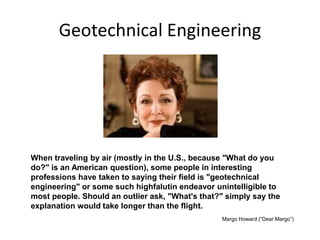Geotheta for Beginners
Table of ContentsThe 10-Minute Rule for GeothetaThe 5-Minute Rule for GeothetaThe 25-Second Trick For GeothetaGeotheta Can Be Fun For EveryoneAn Unbiased View of Geotheta

They carry out site investigations, collect examples, carry out laboratory examinations, and assess information to examine the viability of the ground for building and construction projects - Geo Tech Engineer. Based on their findings, geotechnical designers provide suggestions for structure design, incline security, preserving structures, and mitigation of geotechnical risks. They team up with various other experts, such as designers, architectural engineers, and building and construction groups, to make sure that geotechnical factors to consider are incorporated into the overall job style and implementation
By evaluating the actions and properties of soil and rock, they can determine prospective geotechnical hazards such as landslides, soil negotiation, or slope instability. Their proficiency assists avoid failures or mishaps that might jeopardize lives and property. Here are some detailed responsibilities and responsibilities of a geotechnical designer: Website Investigation: Geotechnical engineers conduct site examinations to gather data on subsurface problems.
They analyze the information to comprehend the residential properties and actions of the soil and rock, including their toughness, permeability, compaction attributes, and groundwater problems. Geotechnical Evaluation and Design: Geotechnical designers assess the data gathered throughout site investigations to examine the stability and suitability of the site for building tasks. They carry out geotechnical estimations and modeling to assess factors such as birthing capacity, negotiation, incline stability, side planet pressures, and groundwater flow.
The Ultimate Guide To Geotheta
Foundation Layout: Geotechnical designers play a crucial role in designing foundations that can securely support the intended structure. They assess the dirt problems and load needs to figure out the proper foundation type, such as superficial foundations (e.g., grounds), deep structures (e.g (https://www.tumblr.com/geotheta/757702666915840000/geotheta-has-grown-exponentially-since?source=share)., stacks), or specialized techniques like soil improvement. They think about aspects such as negotiation restrictions, birthing ability, and soil-structure communication to develop optimal structure designs
They examine building and construction plans, display site activities, and conduct field inspections to confirm that the style referrals are complied with. If unforeseen geotechnical concerns arise, they examine the scenario and provide suggestions for remediation or modifications to the layout. Threat Assessment and Reduction: Geotechnical designers examine geotechnical dangers and threats related to the project website, such as landslides, liquefaction, or dirt disintegration.

Cooperation and Communication: Geotechnical designers work very closely with other specialists included in a task, such as architects, architectural engineers, and building and construction groups. Effective communication and partnership are essential to integrate geotechnical factors to consider into the total job design and building and construction process. Geotechnical engineers supply technical experience, response questions, and guarantee that geotechnical demands are satisfied.
How Geotheta can Save You Time, Stress, and Money.
Right here are some kinds of geotechnical designers: Foundation Designer: Foundation designers concentrate on creating and evaluating structures for frameworks. They assess the soil problems, lots requirements, and site qualities to identify the most proper structure type and style, such as superficial structures, deep structures, or specialized techniques like heap foundations.
They assess the factors affecting incline security, such as dirt buildings, groundwater problems, and incline geometry, and develop approaches to avoid additional reading incline failures and mitigate threats. Quake Designer: Earthquake designers concentrate on assessing and designing structures to withstand seismic pressures. They evaluate the seismic threat of a website, review soil liquefaction possibility, and develop seismic design criteria to ensure the safety and security and resilience of structures during quakes.
They perform area screening, gather examples, and assess the gathered data to identify the dirt properties, geologic formations, and groundwater conditions at a website. Geotechnical Instrumentation Designer: Geotechnical instrumentation designers focus on surveillance and measuring the behavior of dirt, rock, and structures. They install and preserve instrumentation systems that keep track of aspects such as dirt settlement, groundwater levels, slope activities, and architectural displacements to analyze efficiency and give very early cautions of potential issues.
Geotheta Can Be Fun For Everyone
They carry out examinations such as triaxial examinations, loan consolidation tests, straight shear tests, and permeability tests to collect information for geotechnical evaluation and layout. Geosynthetics Designer: Geosynthetics engineers specialize in the layout and application of geosynthetic products, such as geotextiles, geogrids, and geomembranes. They use these materials to enhance dirt stability, reinforce inclines, supply water drainage options, and control disintegration.
They often tend to be investigative individuals, which indicates they're intellectual, introspective, and inquisitive. They wonder, systematic, sensible, analytical, and sensible. A few of them are likewise social, implying they're kind, charitable, cooperative, person, caring, helpful, compassionate, sensible, and friendly. Does this sound like you? Take our cost-free occupation examination to learn if geotechnical designer is just one of your leading career matches.
In the workplace setting, geotechnical designers use specialized software program tools to carry out computations, produce layouts, and examine information. They prepare records, testimonial task requirements, interact with clients and team members, and coordinate project tasks. The office setting provides a helpful atmosphere for study, evaluation, and cooperation with other professionals included in the job.
The 3-Minute Rule for Geotheta
They often visit job sites to carry out website investigations, assess geotechnical problems, and gather information for analysis. These sees include traveling to various locations, often in remote or tough surfaces. Geotechnical engineers might carry out dirt sampling, conduct examinations, and display building tasks to guarantee that the geotechnical facets of the job are being carried out correctly.
Geotechnical designers also work in specialized geotechnical labs. Geotechnical research laboratory designers work extensively in these environments, dealing with testing equipment, operating instruments, and videotaping data.